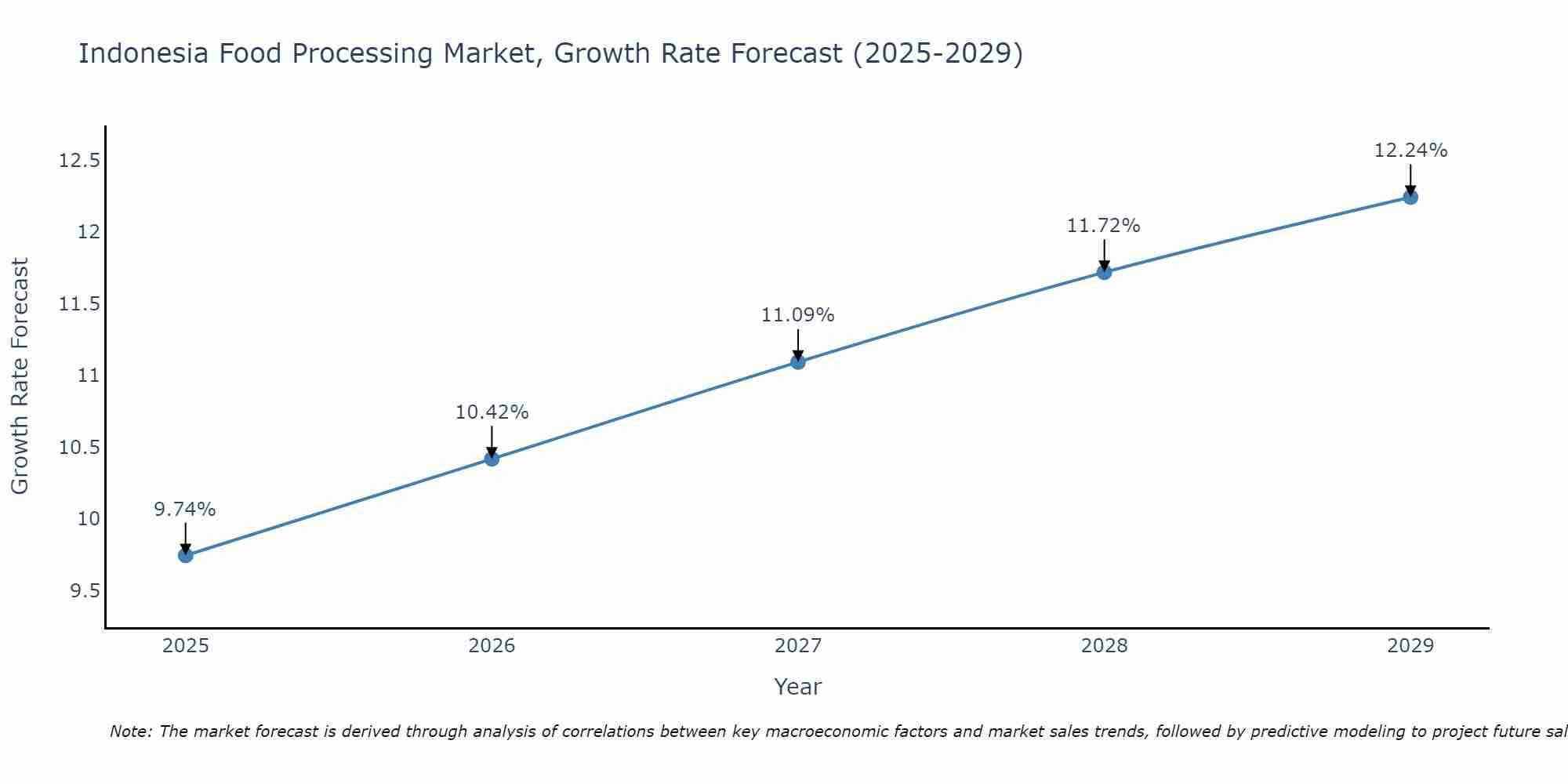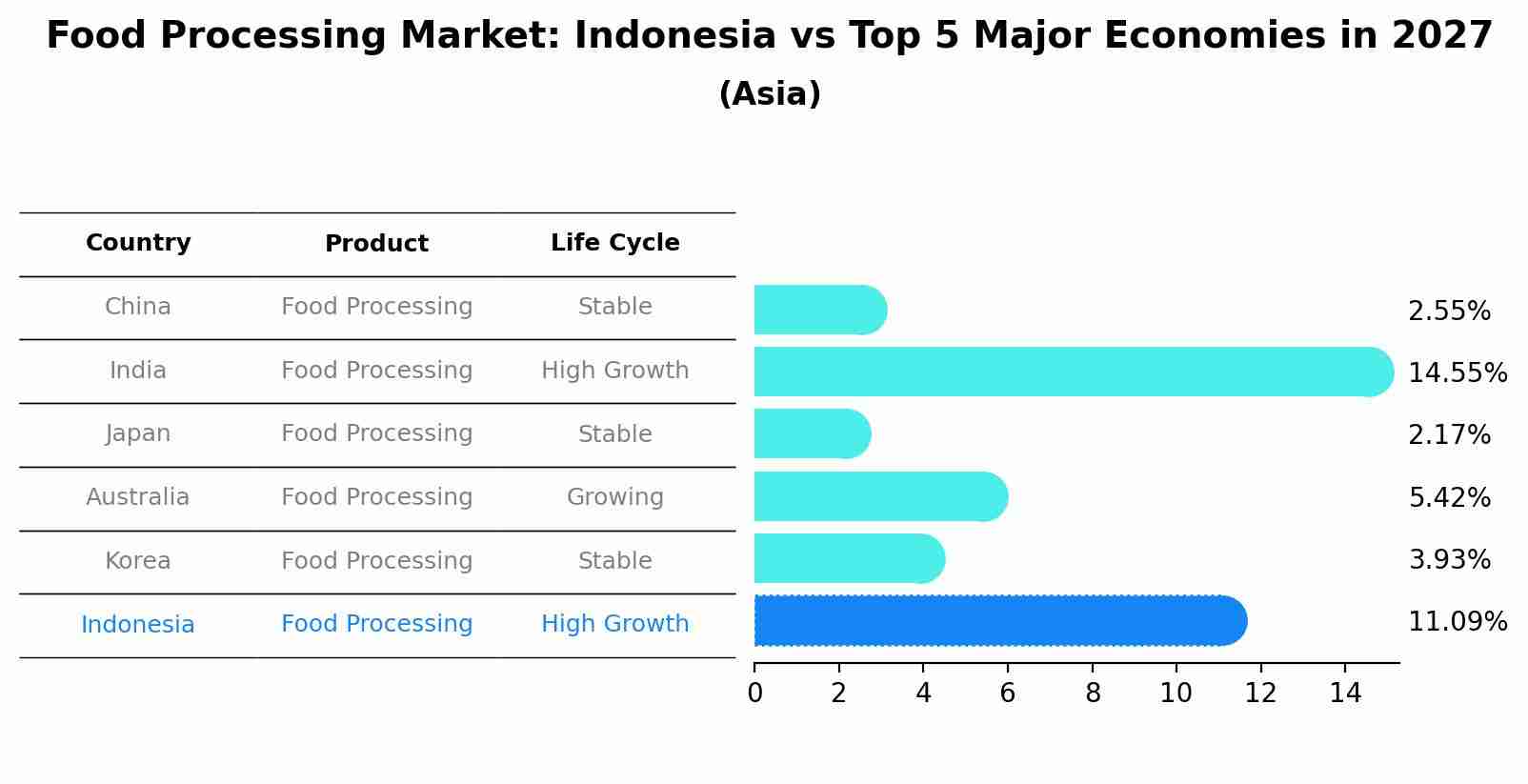Indonesia Food Processing Market (2024-2030) | Value, Forecast, Size, Outlook, Analysis, Revenue, Share, Growth, Trends, Industry & Companies
| Product Code: ETC036588 | Publication Date: Jul 2023 | Updated Date: Aug 2025 | Product Type: Report | |
| Publisher: 6Wresearch | No. of Pages: 70 | No. of Figures: 35 | No. of Tables: 5 | |
Indonesia Food Processing Market Size Growth Rate
The Indonesia Food Processing Market is likely to experience consistent growth rate gains over the period 2025 to 2029. The growth rate starts at 9.74% in 2025 and reaches 12.24% by 2029.

Food Processing Market: Indonesia vs Top 5 Major Economies in 2027 (Asia)
In the Asia region, the Food Processing market in Indonesia is projected to expand at a high growth rate of 11.09% by 2027. The largest economy is China, followed by India, Japan, Australia and South Korea.

Indonesia Food Processing Market Synopsis
The Indonesia Food Processing Market is expected to grow at a significant pace during theperiod (2020-2026). Increasing population and rising disposable income are some of the major drivers for this market. Moreover food processingin Indonesia are investing heavily in technology such as automated production lines and advanced packaging solutions. In addition government initiatives aimed at promoting foreign investments have created favorable business conditions for domestic players as well as multinational firms. The growing demand from regions such as Malaysia Singapore Thailand Vietnam and Brunei has further contributed to theof the food processingin Indonesia.
Key Factors Driving the Market
The increasing disposable incomes among urban consumers are one of the key reasons behind theof the foodacross countries including Indonesia. This has led to an increase in demand for processed foods which has resulted in increased investments from both local and internationaloperating within this sector. Indonesia government initiatives coupled with economic reforms have made it easier for investors to enter into joint ventures with local partners or start their own manufacturing units. These initiatives include tax exemptions on imported raw materials used in production processes along with export incentives on processed products intended for overseas markets. Additionally Government policies on imports exports pricing also facilitate easy access expansion plans by facilitating trade activities between exporters importers.
Challenges Facing the Market
Poor infrastructure continues to remain a major challenge facing manufacturers operating within the country`s food processing sector due to largely inadequate cold chain facilities transportation networks storage capacities. As a result producers often experience difficulties when transporting goods over long distances or preserving them above certain temperature limits before they reach consumers Such challenges can significantly reduce product quality thereby negatively impacting profitability margins overall sales volumes.High cost-related factors associated with setting up new plants also remain another factor hindering potential investment opportunities within this space mainly due to excessive energy costs arising out of power shortages experienced throughout many parts of the country alongside a lack of adequate labor force skilled enough to operate modernized machinery being implemented across industries today making difficult invest capital needed to bring about change technologies currently being used by players here.
Key Highlights of the Report:
- Indonesia Food Processing Market Outlook
- Market Size of Indonesia Food Processing Market, 2023
- Forecast of Indonesia Food Processing Market, 2030
- Historical Data and Forecast of Indonesia Food Processing Revenues & Volume for the Period 2020-2030
- Indonesia Food Processing Market Trend Evolution
- Indonesia Food Processing Market Drivers and Challenges
- Indonesia Food Processing Price Trends
- Indonesia Food Processing Porter's Five Forces
- Indonesia Food Processing Industry Life Cycle
- Historical Data and Forecast of Indonesia Food Processing Market Revenues & Volume By Types for the Period 2020-2030
- Historical Data and Forecast of Indonesia Food Processing Market Revenues & Volume By Primary Food Processing for the Period 2020-2030
- Historical Data and Forecast of Indonesia Food Processing Market Revenues & Volume By Secondary Food Processing for the Period 2020-2030
- Historical Data and Forecast of Indonesia Food Processing Market Revenues & Volume By Tertiary Food Processing for the Period 2020-2030
- Historical Data and Forecast of Indonesia Food Processing Market Revenues & Volume By Applications for the Period 2020-2030
- Historical Data and Forecast of Indonesia Food Processing Market Revenues & Volume By Vegetable Oil for the Period 2020-2030
- Historical Data and Forecast of Indonesia Food Processing Market Revenues & Volume By Fruits and Vegetables for the Period 2020-2030
- Historical Data and Forecast of Indonesia Food Processing Market Revenues & Volume By Drink for the Period 2020-2030
- Historical Data and Forecast of Indonesia Food Processing Market Revenues & Volume By Puffed Food for the Period 2020-2030
- Historical Data and Forecast of Indonesia Food Processing Market Revenues & Volume By Aquatic Product Processing for the Period 2020-2030
- Historical Data and Forecast of Indonesia Food Processing Market Revenues & Volume By Others for the Period 2020-2030
- Indonesia Food Processing Import Export Trade Statistics
- Market Opportunity Assessment By Types
- Market Opportunity Assessment By Applications
- Indonesia Food Processing Top Companies Market Share
- Indonesia Food Processing Competitive Benchmarking By Technical and Operational Parameters
- Indonesia Food Processing Company Profiles
- Indonesia Food Processing Key Strategic Recommendations
Frequently Asked Questions About the Market Study (FAQs):
1 Executive Summary |
2 Introduction |
2.1 Key Highlights of the Report |
2.2 Report Description |
2.3 Market Scope & Segmentation |
2.4 Research Methodology |
2.5 Assumptions |
3 Indonesia Food Processing Market Overview |
3.1 Indonesia Country Macro Economic Indicators |
3.2 Indonesia Food Processing Market Revenues & Volume, 2020 & 2030F |
3.3 Indonesia Food Processing Market - Industry Life Cycle |
3.4 Indonesia Food Processing Market - Porter's Five Forces |
3.5 Indonesia Food Processing Market Revenues & Volume Share, By Types, 2020 & 2030F |
3.6 Indonesia Food Processing Market Revenues & Volume Share, By Applications, 2020 & 2030F |
4 Indonesia Food Processing Market Dynamics |
4.1 Impact Analysis |
4.2 Market Drivers |
4.2.1 Increasing demand for processed food products due to changing lifestyle and urbanization in Indonesia |
4.2.2 Technological advancements in food processing techniques leading to improved efficiency and quality |
4.2.3 Government initiatives to support the growth of the food processing industry in Indonesia |
4.3 Market Restraints |
4.3.1 Fluctuating raw material prices impacting production costs |
4.3.2 Stringent regulations and compliance requirements in the food processing sector |
4.3.3 Intense competition among food processing companies in Indonesia |
5 Indonesia Food Processing Market Trends |
6 Indonesia Food Processing Market, By Types |
6.1 Indonesia Food Processing Market, By Types |
6.1.1 Overview and Analysis |
6.1.2 Indonesia Food Processing Market Revenues & Volume, By Types, 2020-2030F |
6.1.3 Indonesia Food Processing Market Revenues & Volume, By Primary Food Processing, 2020-2030F |
6.1.4 Indonesia Food Processing Market Revenues & Volume, By Secondary Food Processing, 2020-2030F |
6.1.5 Indonesia Food Processing Market Revenues & Volume, By Tertiary Food Processing, 2020-2030F |
6.2 Indonesia Food Processing Market, By Applications |
6.2.1 Overview and Analysis |
6.2.2 Indonesia Food Processing Market Revenues & Volume, By Vegetable Oil, 2020-2030F |
6.2.3 Indonesia Food Processing Market Revenues & Volume, By Fruits and Vegetables, 2020-2030F |
6.2.4 Indonesia Food Processing Market Revenues & Volume, By Drink, 2020-2030F |
6.2.5 Indonesia Food Processing Market Revenues & Volume, By Puffed Food, 2020-2030F |
6.2.6 Indonesia Food Processing Market Revenues & Volume, By Aquatic Product Processing, 2020-2030F |
6.2.7 Indonesia Food Processing Market Revenues & Volume, By Others, 2020-2030F |
7 Indonesia Food Processing Market Import-Export Trade Statistics |
7.1 Indonesia Food Processing Market Export to Major Countries |
7.2 Indonesia Food Processing Market Imports from Major Countries |
8 Indonesia Food Processing Market Key Performance Indicators |
8.1 Percentage increase in investment in food processing technology and infrastructure |
8.2 Rate of adoption of sustainable and environmentally friendly practices in food processing |
8.3 Number of new product launches and innovations in the food processing market |
8.4 Growth in the number of partnerships and collaborations within the food processing industry in Indonesia |
9 Indonesia Food Processing Market - Opportunity Assessment |
9.1 Indonesia Food Processing Market Opportunity Assessment, By Types, 2020 & 2030F |
9.2 Indonesia Food Processing Market Opportunity Assessment, By Applications, 2020 & 2030F |
10 Indonesia Food Processing Market - Competitive Landscape |
10.1 Indonesia Food Processing Market Revenue Share, By Companies, 2023 |
10.2 Indonesia Food Processing Market Competitive Benchmarking, By Operating and Technical Parameters |
11 Company Profiles |
12 Recommendations |
13 Disclaimer |
- Single User License$ 1,995
- Department License$ 2,400
- Site License$ 3,120
- Global License$ 3,795
Search
Related Reports
- UAE Building Thermal Insulation Market Outlook (2025-2031) | Revenue, Companies, Share, Trends, Growth, Size, Forecast, Industry, Analysis & Value
- Portugal Electronic Document Management Market (2025-2031) | Strategy, Consumer Insights, Analysis, Investment Trends, Opportunities, Growth, Size, Share, Industry, Revenue, Segments, Value, Segmentation, Supply, Forecast, Restraints, Outlook, Competition, Drivers, Trends, Demand, Pricing Analysis, Competitive, Strategic Insights, Companies, Challenges
- France Electronic Document Management Market (2025-2031) | Strategy, Consumer Insights, Analysis, Investment Trends, Opportunities, Growth, Size, Share, Industry, Revenue, Segments, Value, Segmentation, Supply, Forecast, Restraints, Outlook, Competition, Drivers, Trends, Demand, Pricing Analysis, Competitive, Strategic Insights, Companies, Challenges
- Portugal Occupational Health & Safety Services Market (2025-2031) | Strategy, Consumer Insights, Analysis, Investment Trends, Opportunities, Growth, Size, Share, Industry, Revenue, Segments, Value, Segmentation, Supply, Forecast, Restraints, Outlook, Competition, Drivers, Trends, Demand, Pricing Analysis, Competitive, Strategic Insights, Companies, Challenges
- Netherlands Occupational Health and Safety Services Market (2025-2031) | Strategy, Consumer Insights, Analysis, Investment Trends, Opportunities, Growth, Size, Share, Industry, Revenue, Segments, Value, Segmentation, Supply, Forecast, Restraints, Outlook, Competition, Drivers, Trends, Demand, Pricing Analysis, Competitive, Strategic Insights, Companies, Challenges
- Belgium and Luxembourg Facility Management Market (2025-2031) | Strategy, Consumer Insights, Analysis, Investment Trends, Opportunities, Growth, Size, Share, Industry, Revenue, Segments, Value, Segmentation, Supply, Forecast, Restraints, Outlook, Competition, Drivers, Trends, Demand, Pricing Analysis, Competitive, Strategic Insights, Companies, Challenges
- Russia Women Intimate Apparel Market (2025-2031) | Strategy, Consumer Insights, Analysis, Investment Trends, Opportunities, Growth, Size, Share, Industry, Revenue, Segments, Value, Segmentation, Supply, Forecast, Restraints, Outlook, Competition, Drivers, Trends, Demand, Pricing Analysis, Competitive, Strategic Insights, Companies, Challenges
- Africa Chocolate Market (2025-2031) | Size, Share, Trends, Growth, Revenue, Analysis, Forecast, industry & Outlook
- Global Hydroxychloroquine And Chloroquine Market (2025-2031) | Industry, Trends, Size, Outlook, Growth, Value, Companies, Revenue, Analysis, Share, Forecast
- Saudi Arabia Plant Maintenance Market (2025-2031) | Industry, Size, Growth, Revenue, Value, Companies, Forecast, Analysis, Share & Trends
Industry Events and Analyst Meet
Our Clients
Whitepaper
- Middle East & Africa Commercial Security Market Click here to view more.
- Middle East & Africa Fire Safety Systems & Equipment Market Click here to view more.
- GCC Drone Market Click here to view more.
- Middle East Lighting Fixture Market Click here to view more.
- GCC Physical & Perimeter Security Market Click here to view more.
6WResearch In News
- Doha a strategic location for EV manufacturing hub: IPA Qatar
- Demand for luxury TVs surging in the GCC, says Samsung
- Empowering Growth: The Thriving Journey of Bangladesh’s Cable Industry
- Demand for luxury TVs surging in the GCC, says Samsung
- Video call with a traditional healer? Once unthinkable, it’s now common in South Africa
- Intelligent Buildings To Smooth GCC’s Path To Net Zero













